Analyzing Intercultural Communication Challenges: Case Study
VerifiedAdded on 2021/05/31
|12
|2742
|174
Case Study
AI Summary
This case study examines the intercultural communication challenges faced by a multinational corporation operating in India, Vietnam, Oman, Nigeria, and Australia. The analysis focuses on two key issues: the ineffective use of social media for internal communication and the lack of quality customer feedback. The study highlights how these issues lead to misunderstandings and a lack of trust across cultures. The report delves into the importance of effective intercultural communication, emphasizing the need for direct communication methods and robust customer feedback mechanisms. Recommendations include implementing direct communication channels like video conferencing and establishing a customer feedback system with a grievance cell to address the identified communication gaps. This analysis aims to provide practical strategies for improving communication and fostering a more cohesive and effective multinational environment.
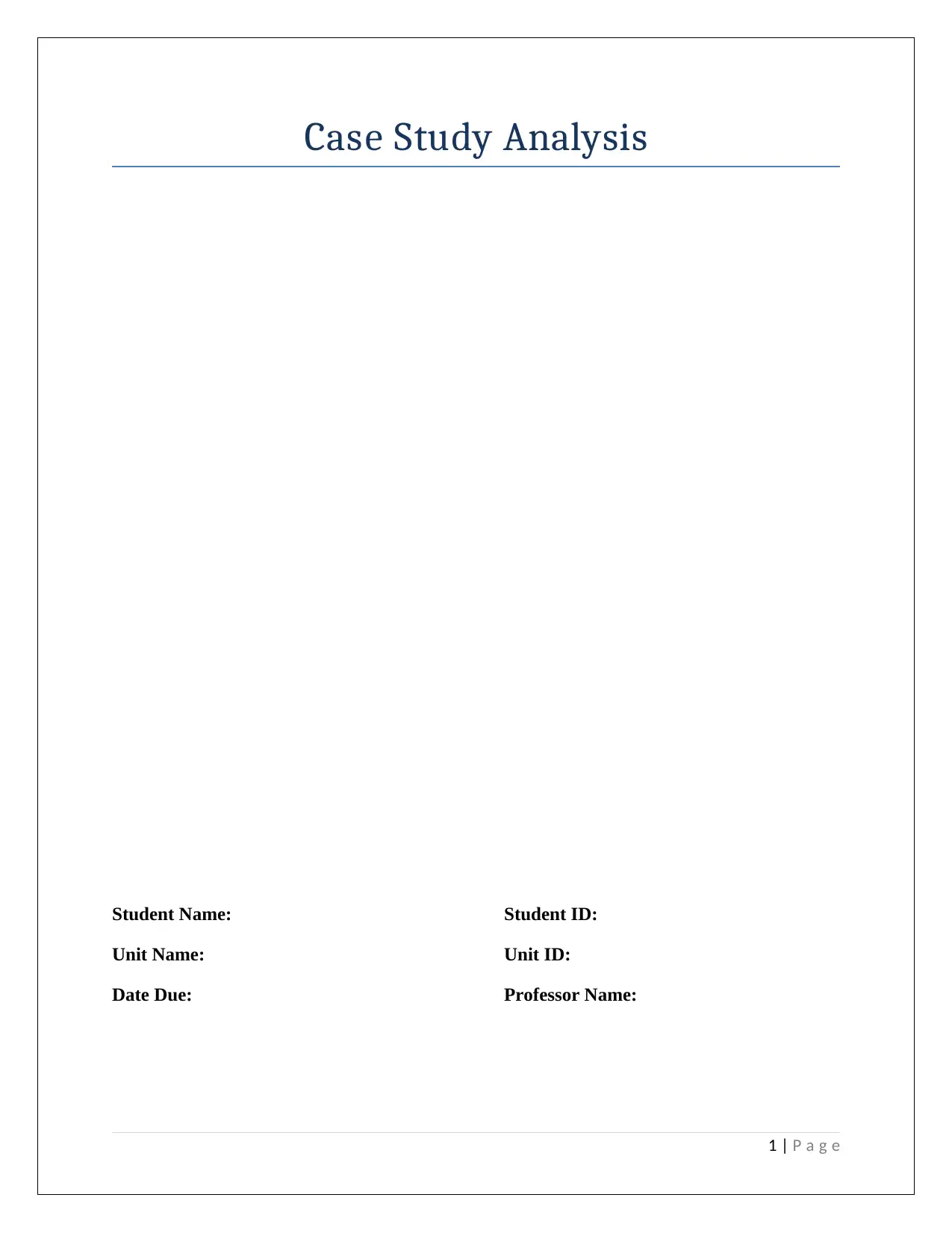
Case Study Analysis
Student Name: Student ID:
Unit Name: Unit ID:
Date Due: Professor Name:
1 | P a g e
Student Name: Student ID:
Unit Name: Unit ID:
Date Due: Professor Name:
1 | P a g e
Paraphrase This Document
Need a fresh take? Get an instant paraphrase of this document with our AI Paraphraser
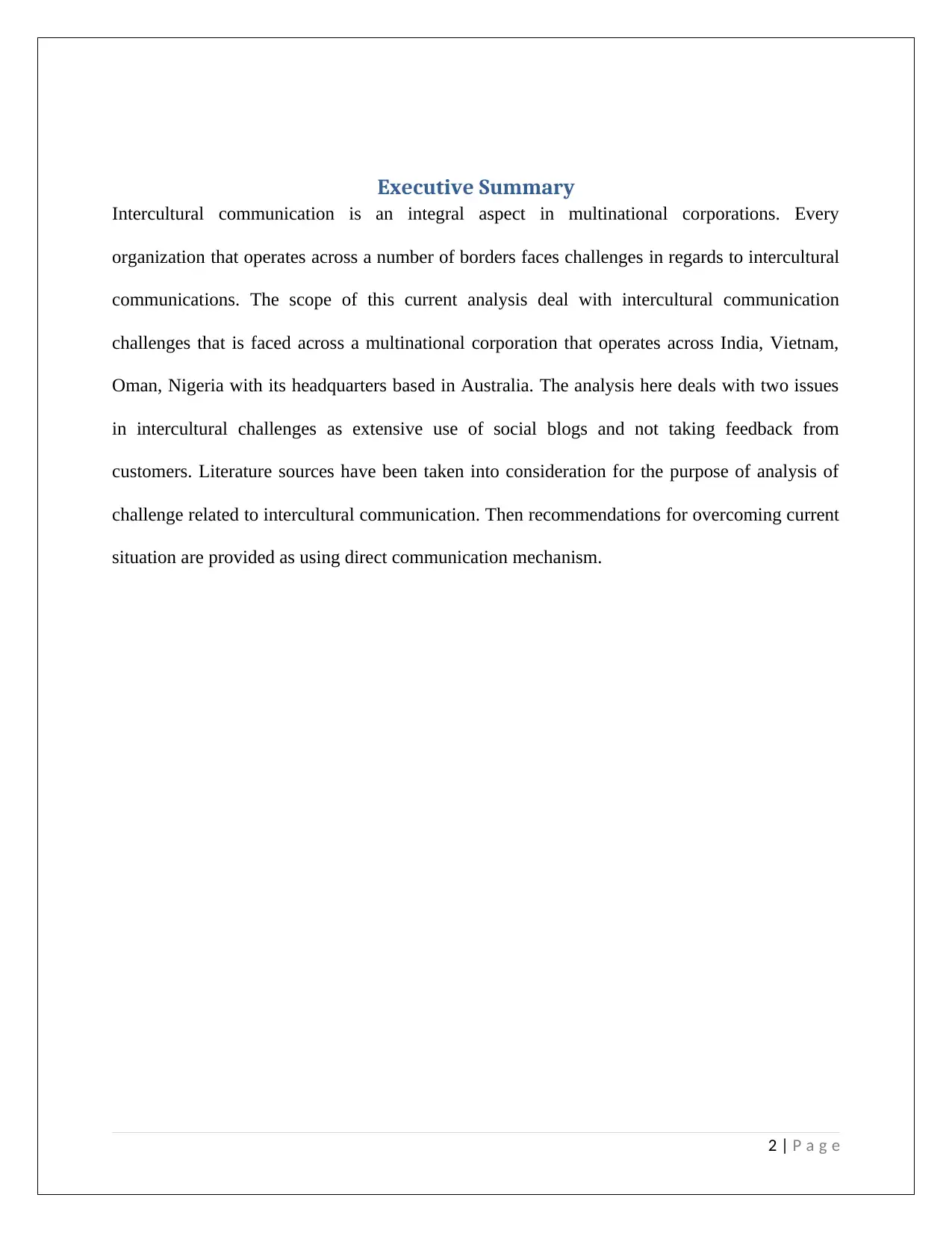
Executive Summary
Intercultural communication is an integral aspect in multinational corporations. Every
organization that operates across a number of borders faces challenges in regards to intercultural
communications. The scope of this current analysis deal with intercultural communication
challenges that is faced across a multinational corporation that operates across India, Vietnam,
Oman, Nigeria with its headquarters based in Australia. The analysis here deals with two issues
in intercultural challenges as extensive use of social blogs and not taking feedback from
customers. Literature sources have been taken into consideration for the purpose of analysis of
challenge related to intercultural communication. Then recommendations for overcoming current
situation are provided as using direct communication mechanism.
2 | P a g e
Intercultural communication is an integral aspect in multinational corporations. Every
organization that operates across a number of borders faces challenges in regards to intercultural
communications. The scope of this current analysis deal with intercultural communication
challenges that is faced across a multinational corporation that operates across India, Vietnam,
Oman, Nigeria with its headquarters based in Australia. The analysis here deals with two issues
in intercultural challenges as extensive use of social blogs and not taking feedback from
customers. Literature sources have been taken into consideration for the purpose of analysis of
challenge related to intercultural communication. Then recommendations for overcoming current
situation are provided as using direct communication mechanism.
2 | P a g e
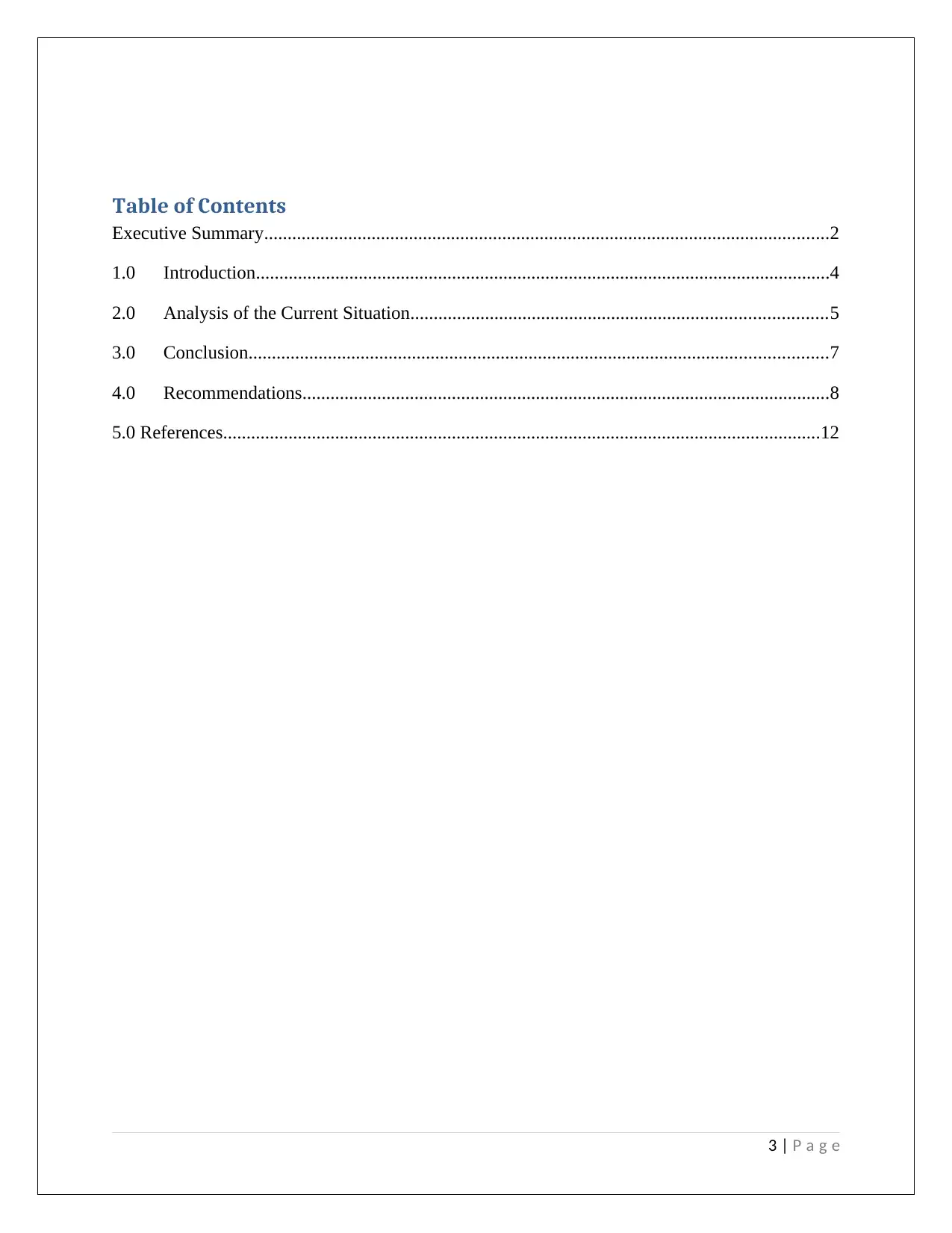
Table of Contents
Executive Summary.........................................................................................................................2
1.0 Introduction...........................................................................................................................4
2.0 Analysis of the Current Situation.........................................................................................5
3.0 Conclusion............................................................................................................................7
4.0 Recommendations.................................................................................................................8
5.0 References................................................................................................................................12
3 | P a g e
Executive Summary.........................................................................................................................2
1.0 Introduction...........................................................................................................................4
2.0 Analysis of the Current Situation.........................................................................................5
3.0 Conclusion............................................................................................................................7
4.0 Recommendations.................................................................................................................8
5.0 References................................................................................................................................12
3 | P a g e
⊘ This is a preview!⊘
Do you want full access?
Subscribe today to unlock all pages.

Trusted by 1+ million students worldwide
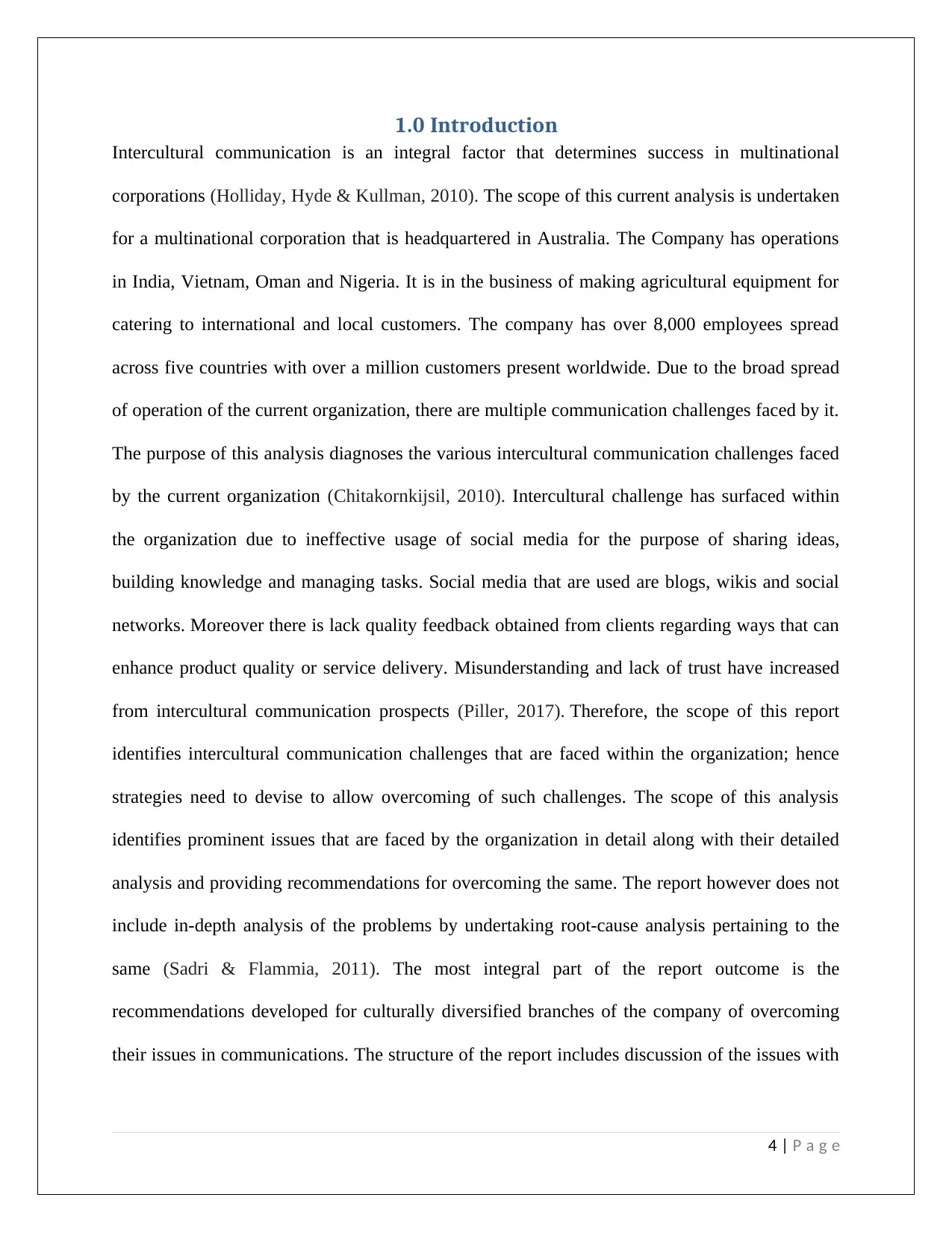
1.0 Introduction
Intercultural communication is an integral factor that determines success in multinational
corporations (Holliday, Hyde & Kullman, 2010). The scope of this current analysis is undertaken
for a multinational corporation that is headquartered in Australia. The Company has operations
in India, Vietnam, Oman and Nigeria. It is in the business of making agricultural equipment for
catering to international and local customers. The company has over 8,000 employees spread
across five countries with over a million customers present worldwide. Due to the broad spread
of operation of the current organization, there are multiple communication challenges faced by it.
The purpose of this analysis diagnoses the various intercultural communication challenges faced
by the current organization (Chitakornkijsil, 2010). Intercultural challenge has surfaced within
the organization due to ineffective usage of social media for the purpose of sharing ideas,
building knowledge and managing tasks. Social media that are used are blogs, wikis and social
networks. Moreover there is lack quality feedback obtained from clients regarding ways that can
enhance product quality or service delivery. Misunderstanding and lack of trust have increased
from intercultural communication prospects (Piller, 2017). Therefore, the scope of this report
identifies intercultural communication challenges that are faced within the organization; hence
strategies need to devise to allow overcoming of such challenges. The scope of this analysis
identifies prominent issues that are faced by the organization in detail along with their detailed
analysis and providing recommendations for overcoming the same. The report however does not
include in-depth analysis of the problems by undertaking root-cause analysis pertaining to the
same (Sadri & Flammia, 2011). The most integral part of the report outcome is the
recommendations developed for culturally diversified branches of the company of overcoming
their issues in communications. The structure of the report includes discussion of the issues with
4 | P a g e
Intercultural communication is an integral factor that determines success in multinational
corporations (Holliday, Hyde & Kullman, 2010). The scope of this current analysis is undertaken
for a multinational corporation that is headquartered in Australia. The Company has operations
in India, Vietnam, Oman and Nigeria. It is in the business of making agricultural equipment for
catering to international and local customers. The company has over 8,000 employees spread
across five countries with over a million customers present worldwide. Due to the broad spread
of operation of the current organization, there are multiple communication challenges faced by it.
The purpose of this analysis diagnoses the various intercultural communication challenges faced
by the current organization (Chitakornkijsil, 2010). Intercultural challenge has surfaced within
the organization due to ineffective usage of social media for the purpose of sharing ideas,
building knowledge and managing tasks. Social media that are used are blogs, wikis and social
networks. Moreover there is lack quality feedback obtained from clients regarding ways that can
enhance product quality or service delivery. Misunderstanding and lack of trust have increased
from intercultural communication prospects (Piller, 2017). Therefore, the scope of this report
identifies intercultural communication challenges that are faced within the organization; hence
strategies need to devise to allow overcoming of such challenges. The scope of this analysis
identifies prominent issues that are faced by the organization in detail along with their detailed
analysis and providing recommendations for overcoming the same. The report however does not
include in-depth analysis of the problems by undertaking root-cause analysis pertaining to the
same (Sadri & Flammia, 2011). The most integral part of the report outcome is the
recommendations developed for culturally diversified branches of the company of overcoming
their issues in communications. The structure of the report includes discussion of the issues with
4 | P a g e
Paraphrase This Document
Need a fresh take? Get an instant paraphrase of this document with our AI Paraphraser
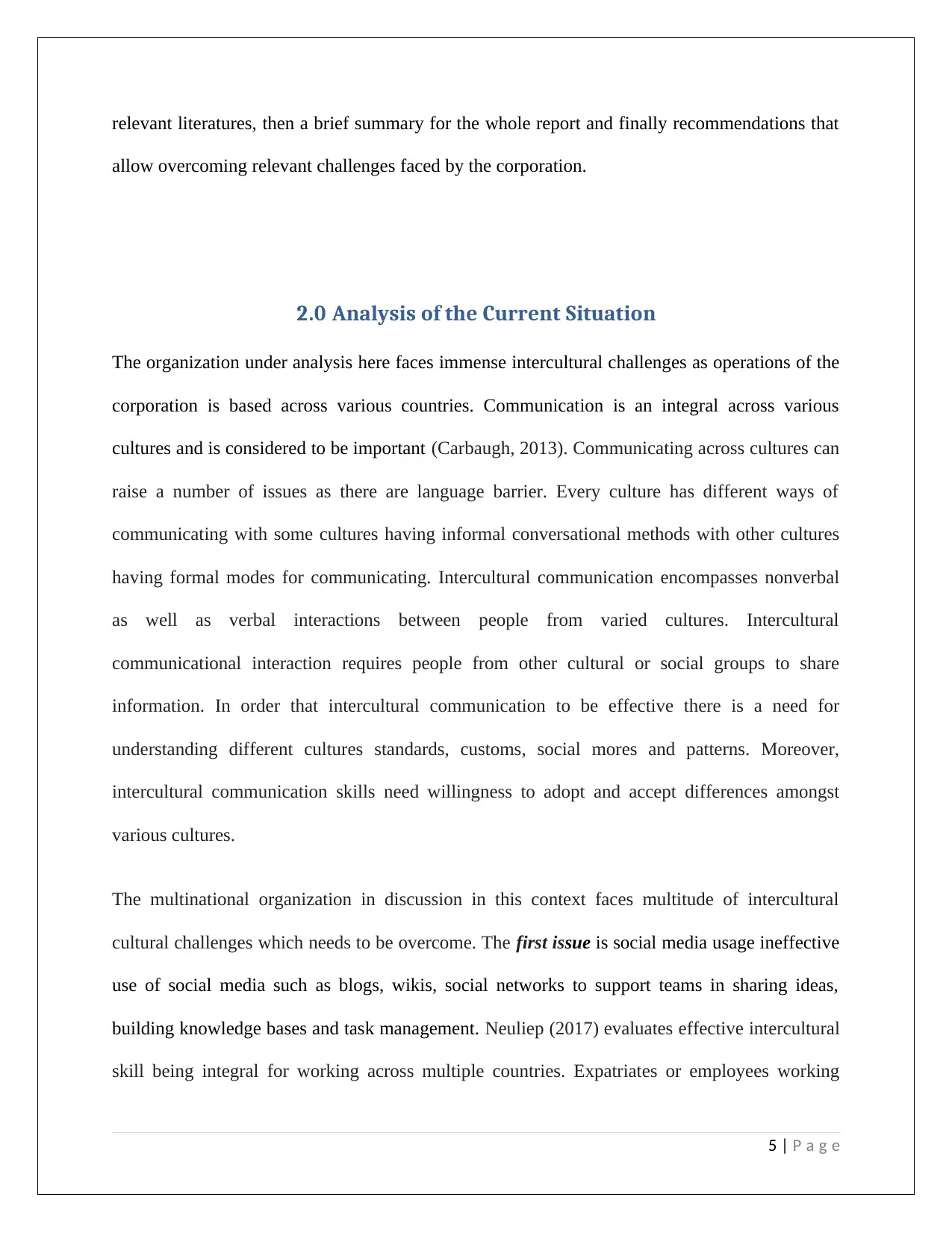
relevant literatures, then a brief summary for the whole report and finally recommendations that
allow overcoming relevant challenges faced by the corporation.
2.0 Analysis of the Current Situation
The organization under analysis here faces immense intercultural challenges as operations of the
corporation is based across various countries. Communication is an integral across various
cultures and is considered to be important (Carbaugh, 2013). Communicating across cultures can
raise a number of issues as there are language barrier. Every culture has different ways of
communicating with some cultures having informal conversational methods with other cultures
having formal modes for communicating. Intercultural communication encompasses nonverbal
as well as verbal interactions between people from varied cultures. Intercultural
communicational interaction requires people from other cultural or social groups to share
information. In order that intercultural communication to be effective there is a need for
understanding different cultures standards, customs, social mores and patterns. Moreover,
intercultural communication skills need willingness to adopt and accept differences amongst
various cultures.
The multinational organization in discussion in this context faces multitude of intercultural
cultural challenges which needs to be overcome. The first issue is social media usage ineffective
use of social media such as blogs, wikis, social networks to support teams in sharing ideas,
building knowledge bases and task management. Neuliep (2017) evaluates effective intercultural
skill being integral for working across multiple countries. Expatriates or employees working
5 | P a g e
allow overcoming relevant challenges faced by the corporation.
2.0 Analysis of the Current Situation
The organization under analysis here faces immense intercultural challenges as operations of the
corporation is based across various countries. Communication is an integral across various
cultures and is considered to be important (Carbaugh, 2013). Communicating across cultures can
raise a number of issues as there are language barrier. Every culture has different ways of
communicating with some cultures having informal conversational methods with other cultures
having formal modes for communicating. Intercultural communication encompasses nonverbal
as well as verbal interactions between people from varied cultures. Intercultural
communicational interaction requires people from other cultural or social groups to share
information. In order that intercultural communication to be effective there is a need for
understanding different cultures standards, customs, social mores and patterns. Moreover,
intercultural communication skills need willingness to adopt and accept differences amongst
various cultures.
The multinational organization in discussion in this context faces multitude of intercultural
cultural challenges which needs to be overcome. The first issue is social media usage ineffective
use of social media such as blogs, wikis, social networks to support teams in sharing ideas,
building knowledge bases and task management. Neuliep (2017) evaluates effective intercultural
skill being integral for working across multiple countries. Expatriates or employees working
5 | P a g e
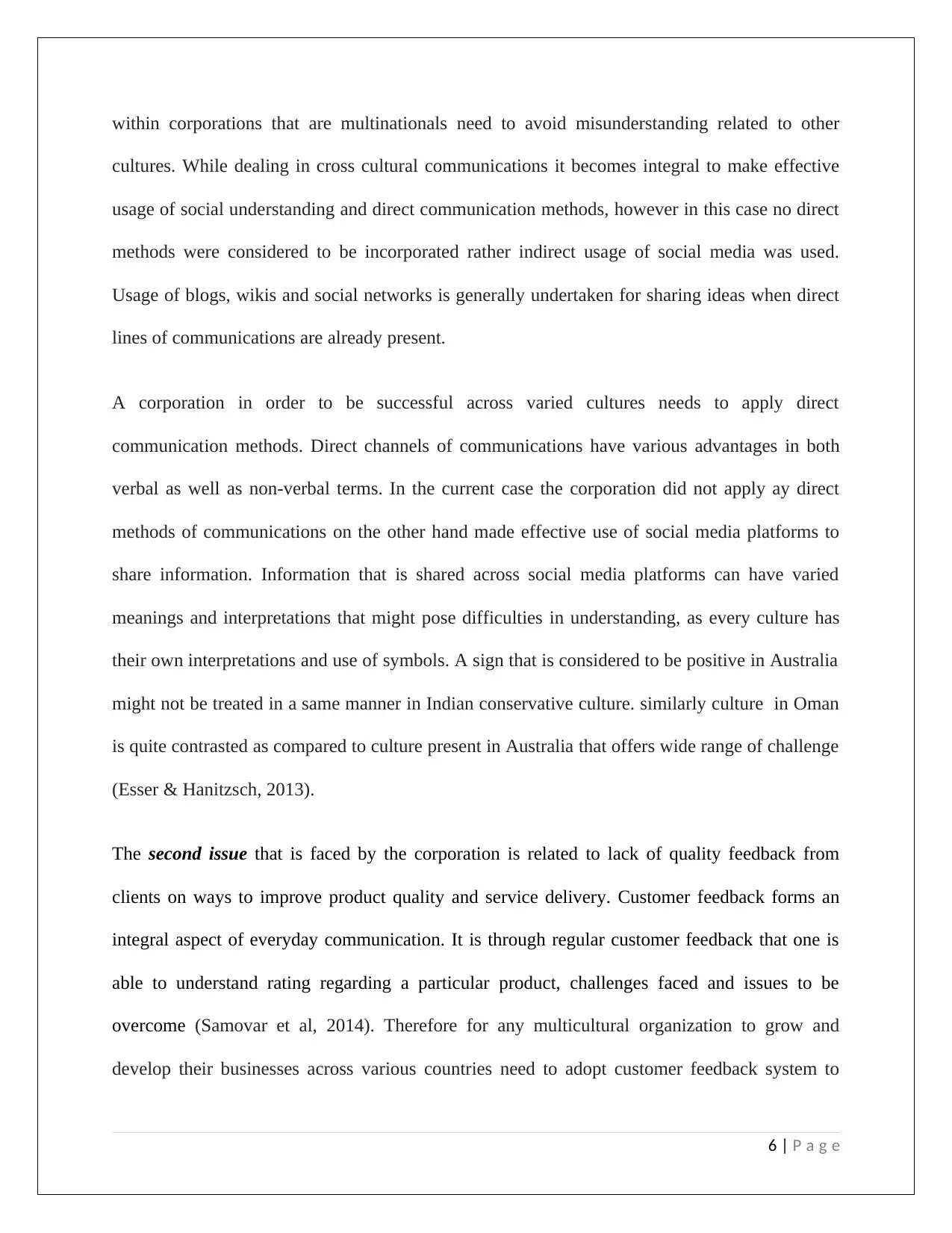
within corporations that are multinationals need to avoid misunderstanding related to other
cultures. While dealing in cross cultural communications it becomes integral to make effective
usage of social understanding and direct communication methods, however in this case no direct
methods were considered to be incorporated rather indirect usage of social media was used.
Usage of blogs, wikis and social networks is generally undertaken for sharing ideas when direct
lines of communications are already present.
A corporation in order to be successful across varied cultures needs to apply direct
communication methods. Direct channels of communications have various advantages in both
verbal as well as non-verbal terms. In the current case the corporation did not apply ay direct
methods of communications on the other hand made effective use of social media platforms to
share information. Information that is shared across social media platforms can have varied
meanings and interpretations that might pose difficulties in understanding, as every culture has
their own interpretations and use of symbols. A sign that is considered to be positive in Australia
might not be treated in a same manner in Indian conservative culture. similarly culture in Oman
is quite contrasted as compared to culture present in Australia that offers wide range of challenge
(Esser & Hanitzsch, 2013).
The second issue that is faced by the corporation is related to lack of quality feedback from
clients on ways to improve product quality and service delivery. Customer feedback forms an
integral aspect of everyday communication. It is through regular customer feedback that one is
able to understand rating regarding a particular product, challenges faced and issues to be
overcome (Samovar et al, 2014). Therefore for any multicultural organization to grow and
develop their businesses across various countries need to adopt customer feedback system to
6 | P a g e
cultures. While dealing in cross cultural communications it becomes integral to make effective
usage of social understanding and direct communication methods, however in this case no direct
methods were considered to be incorporated rather indirect usage of social media was used.
Usage of blogs, wikis and social networks is generally undertaken for sharing ideas when direct
lines of communications are already present.
A corporation in order to be successful across varied cultures needs to apply direct
communication methods. Direct channels of communications have various advantages in both
verbal as well as non-verbal terms. In the current case the corporation did not apply ay direct
methods of communications on the other hand made effective use of social media platforms to
share information. Information that is shared across social media platforms can have varied
meanings and interpretations that might pose difficulties in understanding, as every culture has
their own interpretations and use of symbols. A sign that is considered to be positive in Australia
might not be treated in a same manner in Indian conservative culture. similarly culture in Oman
is quite contrasted as compared to culture present in Australia that offers wide range of challenge
(Esser & Hanitzsch, 2013).
The second issue that is faced by the corporation is related to lack of quality feedback from
clients on ways to improve product quality and service delivery. Customer feedback forms an
integral aspect of everyday communication. It is through regular customer feedback that one is
able to understand rating regarding a particular product, challenges faced and issues to be
overcome (Samovar et al, 2014). Therefore for any multicultural organization to grow and
develop their businesses across various countries need to adopt customer feedback system to
6 | P a g e
⊘ This is a preview!⊘
Do you want full access?
Subscribe today to unlock all pages.

Trusted by 1+ million students worldwide
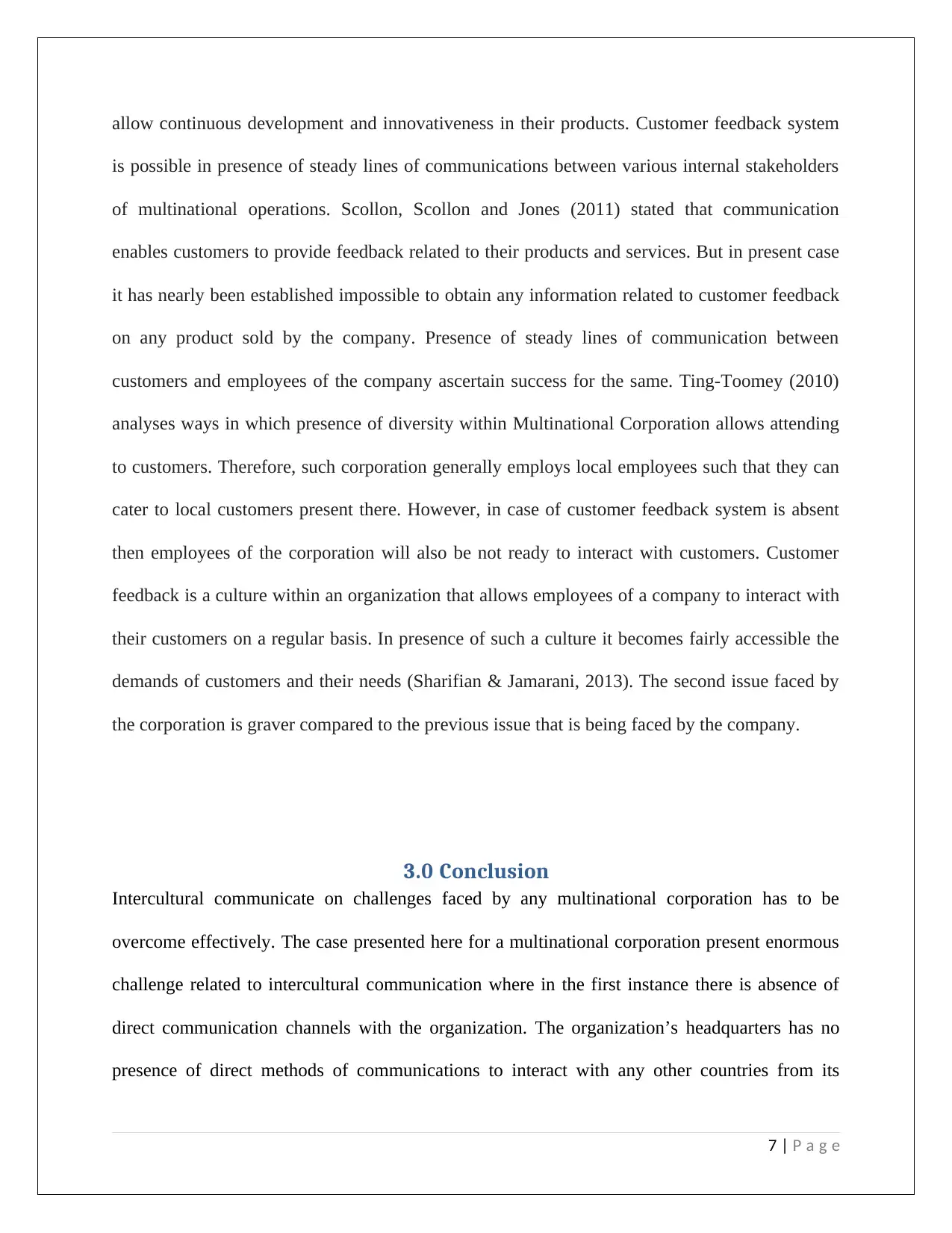
allow continuous development and innovativeness in their products. Customer feedback system
is possible in presence of steady lines of communications between various internal stakeholders
of multinational operations. Scollon, Scollon and Jones (2011) stated that communication
enables customers to provide feedback related to their products and services. But in present case
it has nearly been established impossible to obtain any information related to customer feedback
on any product sold by the company. Presence of steady lines of communication between
customers and employees of the company ascertain success for the same. Ting-Toomey (2010)
analyses ways in which presence of diversity within Multinational Corporation allows attending
to customers. Therefore, such corporation generally employs local employees such that they can
cater to local customers present there. However, in case of customer feedback system is absent
then employees of the corporation will also be not ready to interact with customers. Customer
feedback is a culture within an organization that allows employees of a company to interact with
their customers on a regular basis. In presence of such a culture it becomes fairly accessible the
demands of customers and their needs (Sharifian & Jamarani, 2013). The second issue faced by
the corporation is graver compared to the previous issue that is being faced by the company.
3.0 Conclusion
Intercultural communicate on challenges faced by any multinational corporation has to be
overcome effectively. The case presented here for a multinational corporation present enormous
challenge related to intercultural communication where in the first instance there is absence of
direct communication channels with the organization. The organization’s headquarters has no
presence of direct methods of communications to interact with any other countries from its
7 | P a g e
is possible in presence of steady lines of communications between various internal stakeholders
of multinational operations. Scollon, Scollon and Jones (2011) stated that communication
enables customers to provide feedback related to their products and services. But in present case
it has nearly been established impossible to obtain any information related to customer feedback
on any product sold by the company. Presence of steady lines of communication between
customers and employees of the company ascertain success for the same. Ting-Toomey (2010)
analyses ways in which presence of diversity within Multinational Corporation allows attending
to customers. Therefore, such corporation generally employs local employees such that they can
cater to local customers present there. However, in case of customer feedback system is absent
then employees of the corporation will also be not ready to interact with customers. Customer
feedback is a culture within an organization that allows employees of a company to interact with
their customers on a regular basis. In presence of such a culture it becomes fairly accessible the
demands of customers and their needs (Sharifian & Jamarani, 2013). The second issue faced by
the corporation is graver compared to the previous issue that is being faced by the company.
3.0 Conclusion
Intercultural communicate on challenges faced by any multinational corporation has to be
overcome effectively. The case presented here for a multinational corporation present enormous
challenge related to intercultural communication where in the first instance there is absence of
direct communication channels with the organization. The organization’s headquarters has no
presence of direct methods of communications to interact with any other countries from its
7 | P a g e
Paraphrase This Document
Need a fresh take? Get an instant paraphrase of this document with our AI Paraphraser
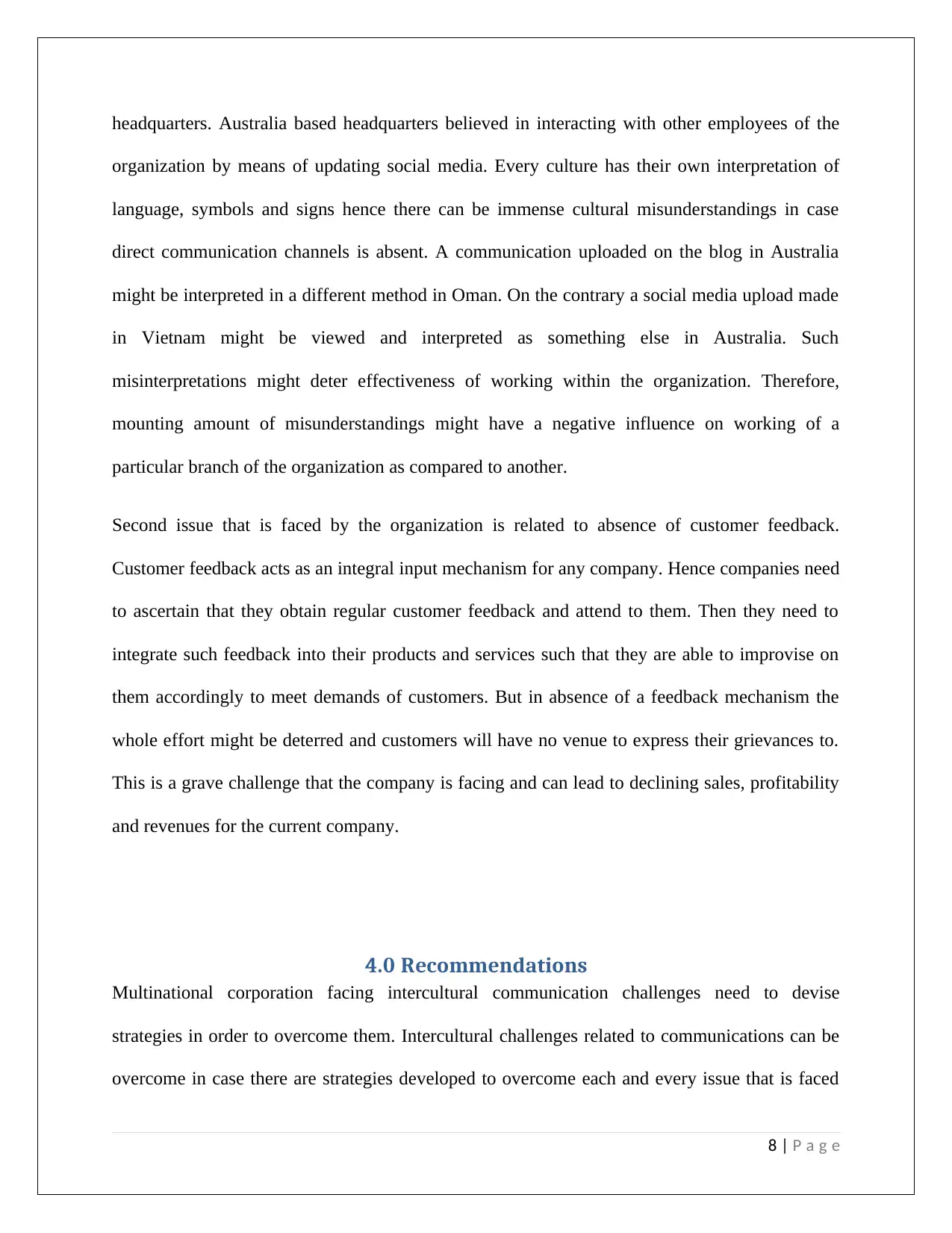
headquarters. Australia based headquarters believed in interacting with other employees of the
organization by means of updating social media. Every culture has their own interpretation of
language, symbols and signs hence there can be immense cultural misunderstandings in case
direct communication channels is absent. A communication uploaded on the blog in Australia
might be interpreted in a different method in Oman. On the contrary a social media upload made
in Vietnam might be viewed and interpreted as something else in Australia. Such
misinterpretations might deter effectiveness of working within the organization. Therefore,
mounting amount of misunderstandings might have a negative influence on working of a
particular branch of the organization as compared to another.
Second issue that is faced by the organization is related to absence of customer feedback.
Customer feedback acts as an integral input mechanism for any company. Hence companies need
to ascertain that they obtain regular customer feedback and attend to them. Then they need to
integrate such feedback into their products and services such that they are able to improvise on
them accordingly to meet demands of customers. But in absence of a feedback mechanism the
whole effort might be deterred and customers will have no venue to express their grievances to.
This is a grave challenge that the company is facing and can lead to declining sales, profitability
and revenues for the current company.
4.0 Recommendations
Multinational corporation facing intercultural communication challenges need to devise
strategies in order to overcome them. Intercultural challenges related to communications can be
overcome in case there are strategies developed to overcome each and every issue that is faced
8 | P a g e
organization by means of updating social media. Every culture has their own interpretation of
language, symbols and signs hence there can be immense cultural misunderstandings in case
direct communication channels is absent. A communication uploaded on the blog in Australia
might be interpreted in a different method in Oman. On the contrary a social media upload made
in Vietnam might be viewed and interpreted as something else in Australia. Such
misinterpretations might deter effectiveness of working within the organization. Therefore,
mounting amount of misunderstandings might have a negative influence on working of a
particular branch of the organization as compared to another.
Second issue that is faced by the organization is related to absence of customer feedback.
Customer feedback acts as an integral input mechanism for any company. Hence companies need
to ascertain that they obtain regular customer feedback and attend to them. Then they need to
integrate such feedback into their products and services such that they are able to improvise on
them accordingly to meet demands of customers. But in absence of a feedback mechanism the
whole effort might be deterred and customers will have no venue to express their grievances to.
This is a grave challenge that the company is facing and can lead to declining sales, profitability
and revenues for the current company.
4.0 Recommendations
Multinational corporation facing intercultural communication challenges need to devise
strategies in order to overcome them. Intercultural challenges related to communications can be
overcome in case there are strategies developed to overcome each and every issue that is faced
8 | P a g e
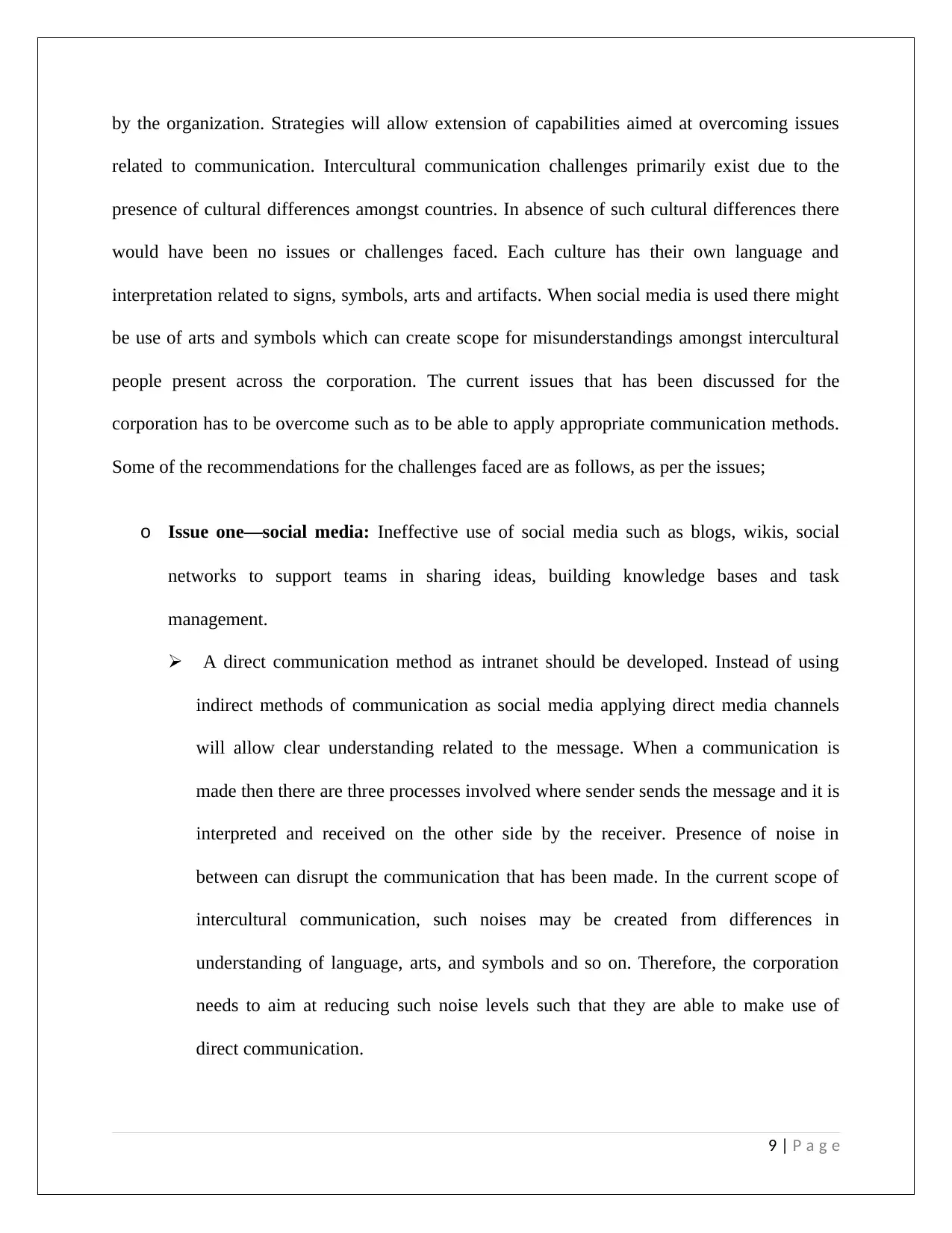
by the organization. Strategies will allow extension of capabilities aimed at overcoming issues
related to communication. Intercultural communication challenges primarily exist due to the
presence of cultural differences amongst countries. In absence of such cultural differences there
would have been no issues or challenges faced. Each culture has their own language and
interpretation related to signs, symbols, arts and artifacts. When social media is used there might
be use of arts and symbols which can create scope for misunderstandings amongst intercultural
people present across the corporation. The current issues that has been discussed for the
corporation has to be overcome such as to be able to apply appropriate communication methods.
Some of the recommendations for the challenges faced are as follows, as per the issues;
o Issue one—social media: Ineffective use of social media such as blogs, wikis, social
networks to support teams in sharing ideas, building knowledge bases and task
management.
A direct communication method as intranet should be developed. Instead of using
indirect methods of communication as social media applying direct media channels
will allow clear understanding related to the message. When a communication is
made then there are three processes involved where sender sends the message and it is
interpreted and received on the other side by the receiver. Presence of noise in
between can disrupt the communication that has been made. In the current scope of
intercultural communication, such noises may be created from differences in
understanding of language, arts, and symbols and so on. Therefore, the corporation
needs to aim at reducing such noise levels such that they are able to make use of
direct communication.
9 | P a g e
related to communication. Intercultural communication challenges primarily exist due to the
presence of cultural differences amongst countries. In absence of such cultural differences there
would have been no issues or challenges faced. Each culture has their own language and
interpretation related to signs, symbols, arts and artifacts. When social media is used there might
be use of arts and symbols which can create scope for misunderstandings amongst intercultural
people present across the corporation. The current issues that has been discussed for the
corporation has to be overcome such as to be able to apply appropriate communication methods.
Some of the recommendations for the challenges faced are as follows, as per the issues;
o Issue one—social media: Ineffective use of social media such as blogs, wikis, social
networks to support teams in sharing ideas, building knowledge bases and task
management.
A direct communication method as intranet should be developed. Instead of using
indirect methods of communication as social media applying direct media channels
will allow clear understanding related to the message. When a communication is
made then there are three processes involved where sender sends the message and it is
interpreted and received on the other side by the receiver. Presence of noise in
between can disrupt the communication that has been made. In the current scope of
intercultural communication, such noises may be created from differences in
understanding of language, arts, and symbols and so on. Therefore, the corporation
needs to aim at reducing such noise levels such that they are able to make use of
direct communication.
9 | P a g e
⊘ This is a preview!⊘
Do you want full access?
Subscribe today to unlock all pages.

Trusted by 1+ million students worldwide
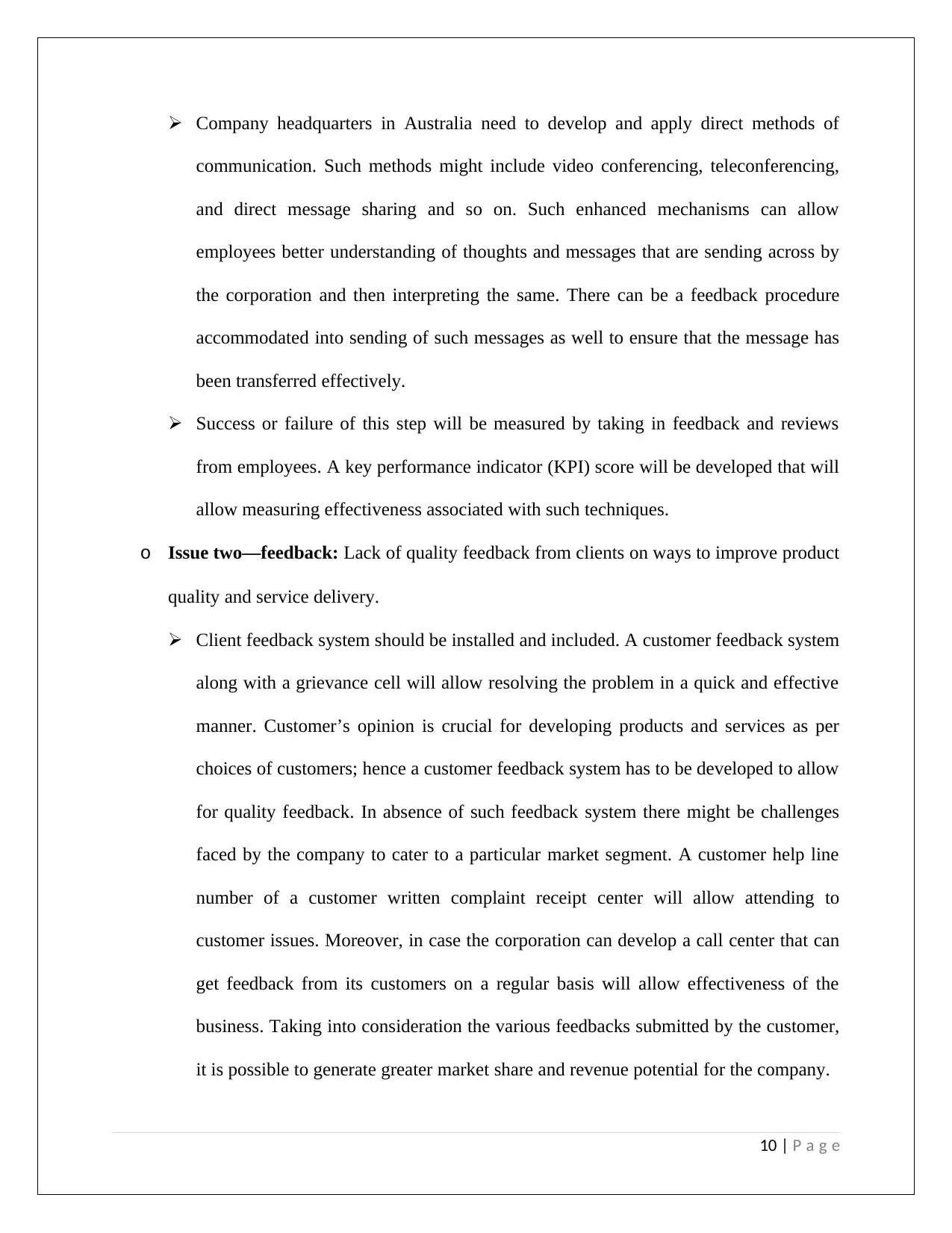
Company headquarters in Australia need to develop and apply direct methods of
communication. Such methods might include video conferencing, teleconferencing,
and direct message sharing and so on. Such enhanced mechanisms can allow
employees better understanding of thoughts and messages that are sending across by
the corporation and then interpreting the same. There can be a feedback procedure
accommodated into sending of such messages as well to ensure that the message has
been transferred effectively.
Success or failure of this step will be measured by taking in feedback and reviews
from employees. A key performance indicator (KPI) score will be developed that will
allow measuring effectiveness associated with such techniques.
o Issue two—feedback: Lack of quality feedback from clients on ways to improve product
quality and service delivery.
Client feedback system should be installed and included. A customer feedback system
along with a grievance cell will allow resolving the problem in a quick and effective
manner. Customer’s opinion is crucial for developing products and services as per
choices of customers; hence a customer feedback system has to be developed to allow
for quality feedback. In absence of such feedback system there might be challenges
faced by the company to cater to a particular market segment. A customer help line
number of a customer written complaint receipt center will allow attending to
customer issues. Moreover, in case the corporation can develop a call center that can
get feedback from its customers on a regular basis will allow effectiveness of the
business. Taking into consideration the various feedbacks submitted by the customer,
it is possible to generate greater market share and revenue potential for the company.
10 | P a g e
communication. Such methods might include video conferencing, teleconferencing,
and direct message sharing and so on. Such enhanced mechanisms can allow
employees better understanding of thoughts and messages that are sending across by
the corporation and then interpreting the same. There can be a feedback procedure
accommodated into sending of such messages as well to ensure that the message has
been transferred effectively.
Success or failure of this step will be measured by taking in feedback and reviews
from employees. A key performance indicator (KPI) score will be developed that will
allow measuring effectiveness associated with such techniques.
o Issue two—feedback: Lack of quality feedback from clients on ways to improve product
quality and service delivery.
Client feedback system should be installed and included. A customer feedback system
along with a grievance cell will allow resolving the problem in a quick and effective
manner. Customer’s opinion is crucial for developing products and services as per
choices of customers; hence a customer feedback system has to be developed to allow
for quality feedback. In absence of such feedback system there might be challenges
faced by the company to cater to a particular market segment. A customer help line
number of a customer written complaint receipt center will allow attending to
customer issues. Moreover, in case the corporation can develop a call center that can
get feedback from its customers on a regular basis will allow effectiveness of the
business. Taking into consideration the various feedbacks submitted by the customer,
it is possible to generate greater market share and revenue potential for the company.
10 | P a g e
Paraphrase This Document
Need a fresh take? Get an instant paraphrase of this document with our AI Paraphraser
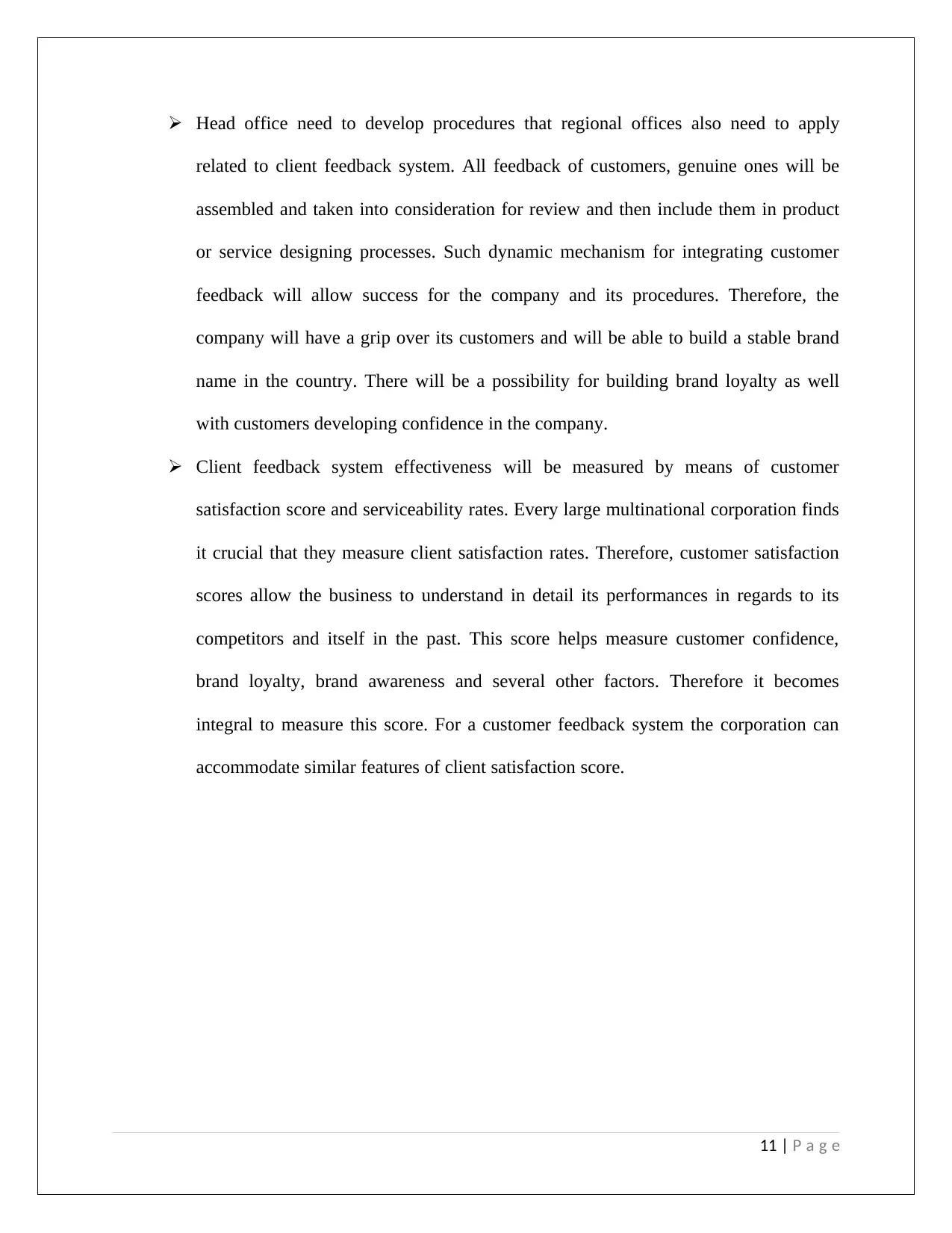
Head office need to develop procedures that regional offices also need to apply
related to client feedback system. All feedback of customers, genuine ones will be
assembled and taken into consideration for review and then include them in product
or service designing processes. Such dynamic mechanism for integrating customer
feedback will allow success for the company and its procedures. Therefore, the
company will have a grip over its customers and will be able to build a stable brand
name in the country. There will be a possibility for building brand loyalty as well
with customers developing confidence in the company.
Client feedback system effectiveness will be measured by means of customer
satisfaction score and serviceability rates. Every large multinational corporation finds
it crucial that they measure client satisfaction rates. Therefore, customer satisfaction
scores allow the business to understand in detail its performances in regards to its
competitors and itself in the past. This score helps measure customer confidence,
brand loyalty, brand awareness and several other factors. Therefore it becomes
integral to measure this score. For a customer feedback system the corporation can
accommodate similar features of client satisfaction score.
11 | P a g e
related to client feedback system. All feedback of customers, genuine ones will be
assembled and taken into consideration for review and then include them in product
or service designing processes. Such dynamic mechanism for integrating customer
feedback will allow success for the company and its procedures. Therefore, the
company will have a grip over its customers and will be able to build a stable brand
name in the country. There will be a possibility for building brand loyalty as well
with customers developing confidence in the company.
Client feedback system effectiveness will be measured by means of customer
satisfaction score and serviceability rates. Every large multinational corporation finds
it crucial that they measure client satisfaction rates. Therefore, customer satisfaction
scores allow the business to understand in detail its performances in regards to its
competitors and itself in the past. This score helps measure customer confidence,
brand loyalty, brand awareness and several other factors. Therefore it becomes
integral to measure this score. For a customer feedback system the corporation can
accommodate similar features of client satisfaction score.
11 | P a g e
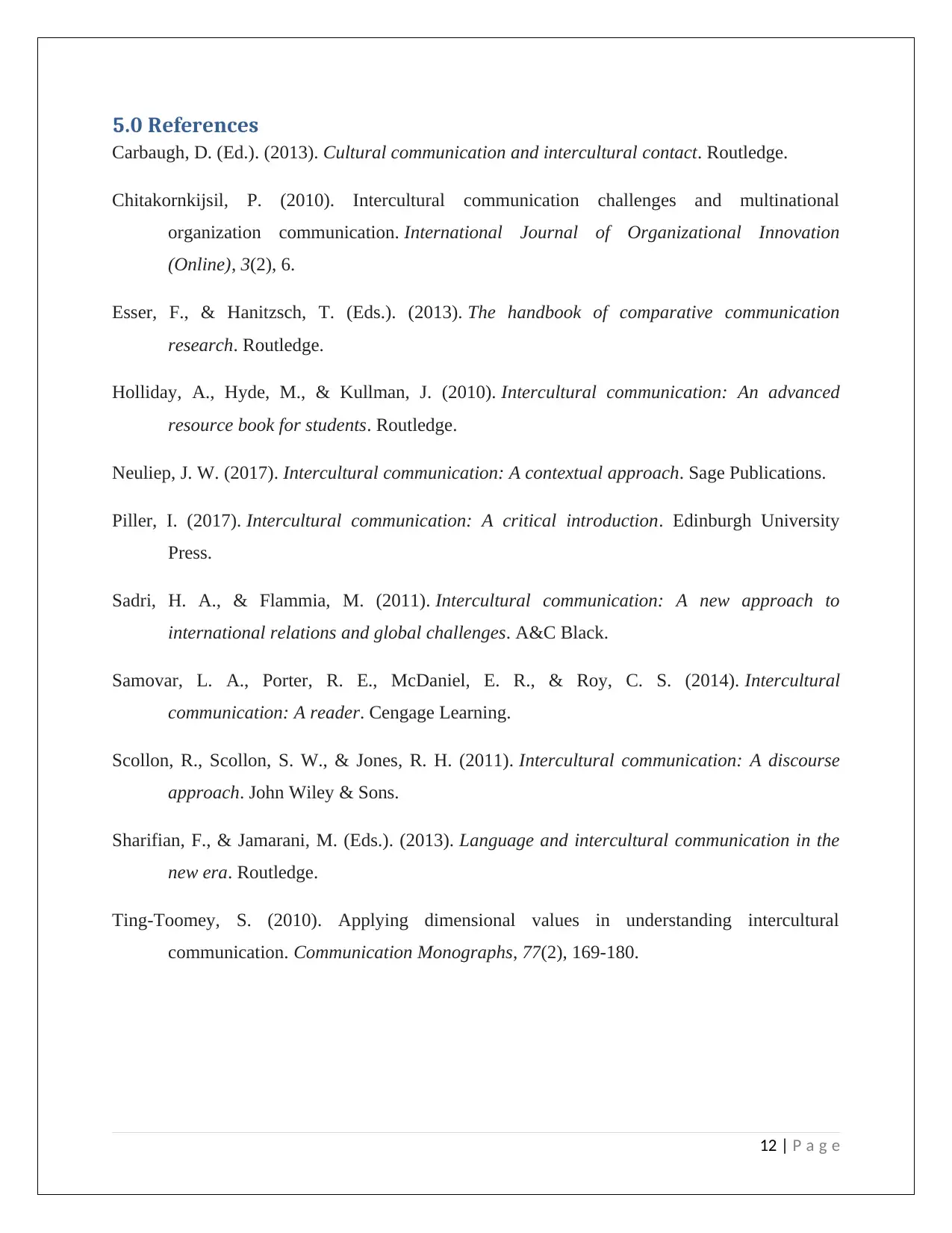
5.0 References
Carbaugh, D. (Ed.). (2013). Cultural communication and intercultural contact. Routledge.
Chitakornkijsil, P. (2010). Intercultural communication challenges and multinational
organization communication. International Journal of Organizational Innovation
(Online), 3(2), 6.
Esser, F., & Hanitzsch, T. (Eds.). (2013). The handbook of comparative communication
research. Routledge.
Holliday, A., Hyde, M., & Kullman, J. (2010). Intercultural communication: An advanced
resource book for students. Routledge.
Neuliep, J. W. (2017). Intercultural communication: A contextual approach. Sage Publications.
Piller, I. (2017). Intercultural communication: A critical introduction. Edinburgh University
Press.
Sadri, H. A., & Flammia, M. (2011). Intercultural communication: A new approach to
international relations and global challenges. A&C Black.
Samovar, L. A., Porter, R. E., McDaniel, E. R., & Roy, C. S. (2014). Intercultural
communication: A reader. Cengage Learning.
Scollon, R., Scollon, S. W., & Jones, R. H. (2011). Intercultural communication: A discourse
approach. John Wiley & Sons.
Sharifian, F., & Jamarani, M. (Eds.). (2013). Language and intercultural communication in the
new era. Routledge.
Ting-Toomey, S. (2010). Applying dimensional values in understanding intercultural
communication. Communication Monographs, 77(2), 169-180.
12 | P a g e
Carbaugh, D. (Ed.). (2013). Cultural communication and intercultural contact. Routledge.
Chitakornkijsil, P. (2010). Intercultural communication challenges and multinational
organization communication. International Journal of Organizational Innovation
(Online), 3(2), 6.
Esser, F., & Hanitzsch, T. (Eds.). (2013). The handbook of comparative communication
research. Routledge.
Holliday, A., Hyde, M., & Kullman, J. (2010). Intercultural communication: An advanced
resource book for students. Routledge.
Neuliep, J. W. (2017). Intercultural communication: A contextual approach. Sage Publications.
Piller, I. (2017). Intercultural communication: A critical introduction. Edinburgh University
Press.
Sadri, H. A., & Flammia, M. (2011). Intercultural communication: A new approach to
international relations and global challenges. A&C Black.
Samovar, L. A., Porter, R. E., McDaniel, E. R., & Roy, C. S. (2014). Intercultural
communication: A reader. Cengage Learning.
Scollon, R., Scollon, S. W., & Jones, R. H. (2011). Intercultural communication: A discourse
approach. John Wiley & Sons.
Sharifian, F., & Jamarani, M. (Eds.). (2013). Language and intercultural communication in the
new era. Routledge.
Ting-Toomey, S. (2010). Applying dimensional values in understanding intercultural
communication. Communication Monographs, 77(2), 169-180.
12 | P a g e
⊘ This is a preview!⊘
Do you want full access?
Subscribe today to unlock all pages.

Trusted by 1+ million students worldwide
1 out of 12
Related Documents
Your All-in-One AI-Powered Toolkit for Academic Success.
+13062052269
info@desklib.com
Available 24*7 on WhatsApp / Email
![[object Object]](/_next/static/media/star-bottom.7253800d.svg)
Unlock your academic potential
Copyright © 2020–2025 A2Z Services. All Rights Reserved. Developed and managed by ZUCOL.





![Effective Business Communication Report for [University Name/Course]](/_next/image/?url=https%3A%2F%2Fdesklib.com%2Fmedia%2Fimages%2Fcp%2Fc61a70ff1cde4733ab3fe1707c45f9cd.jpg&w=256&q=75)